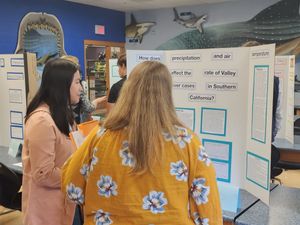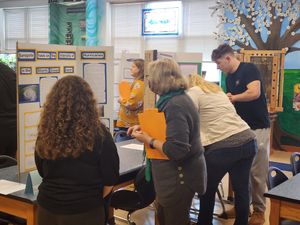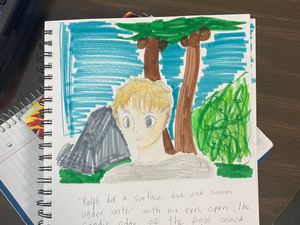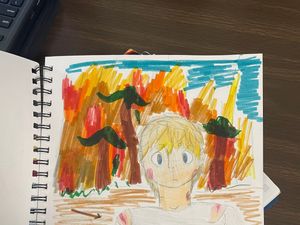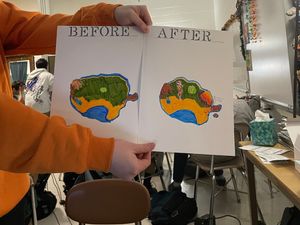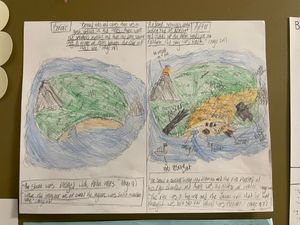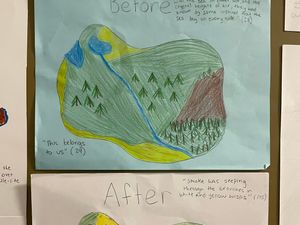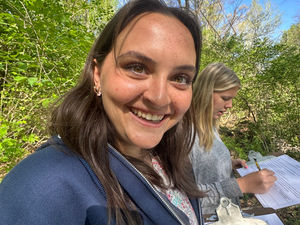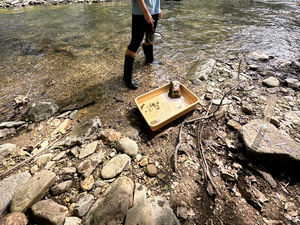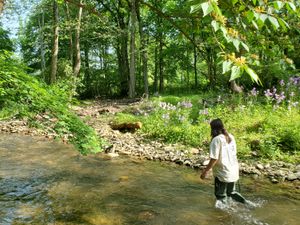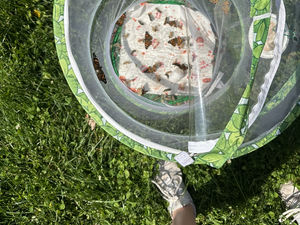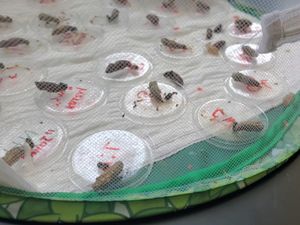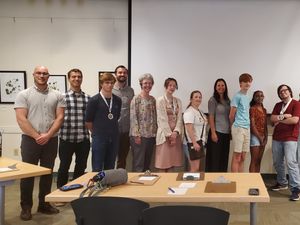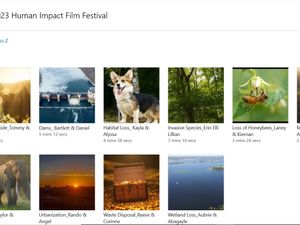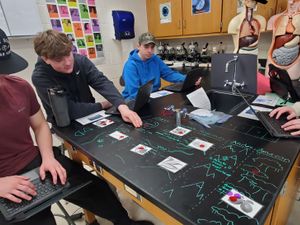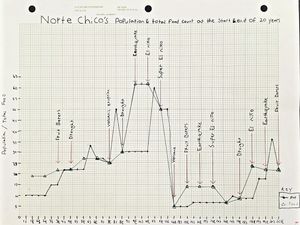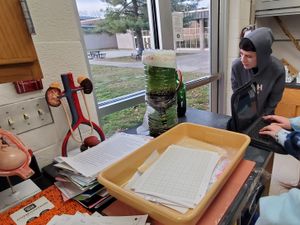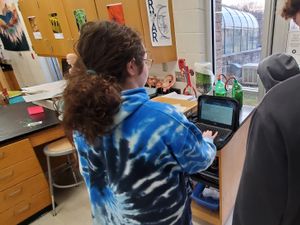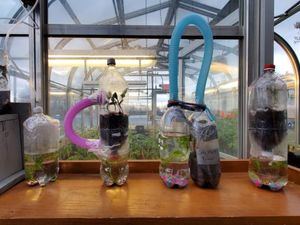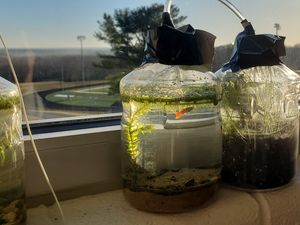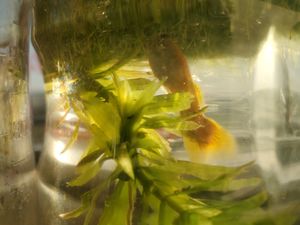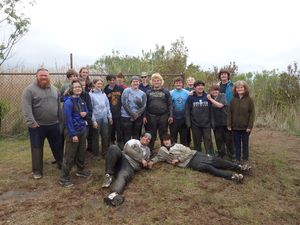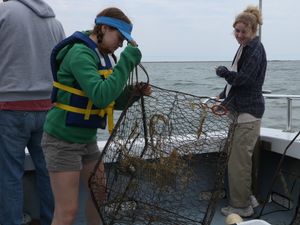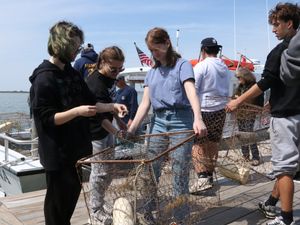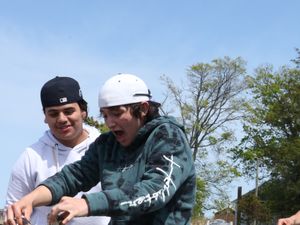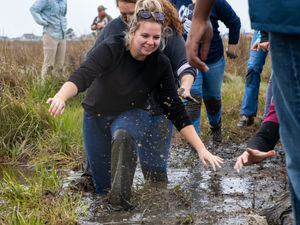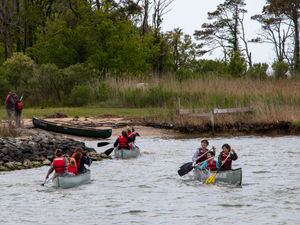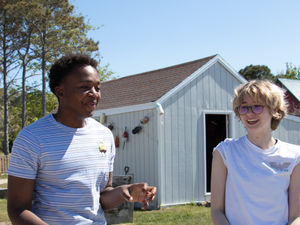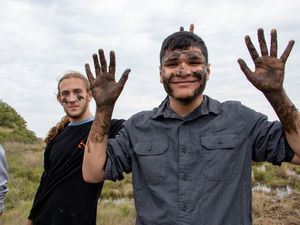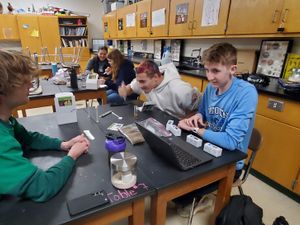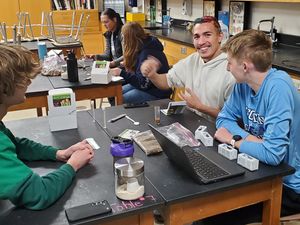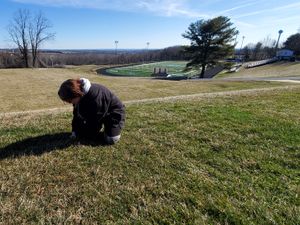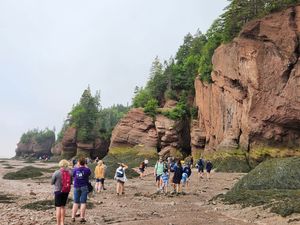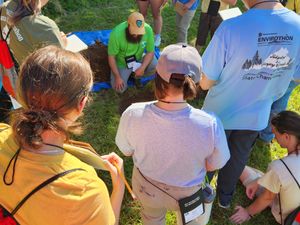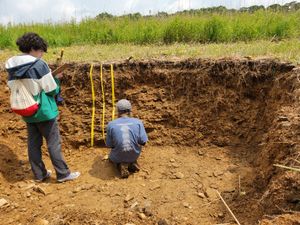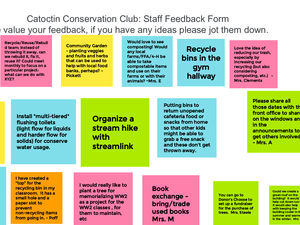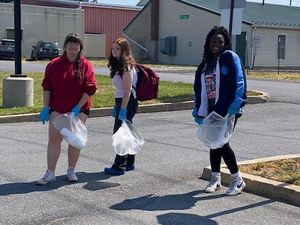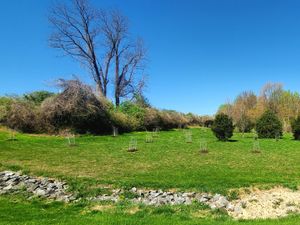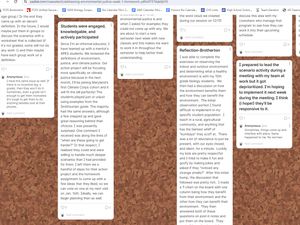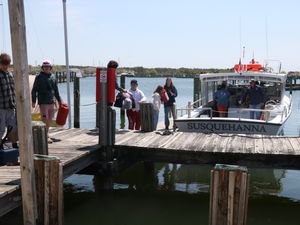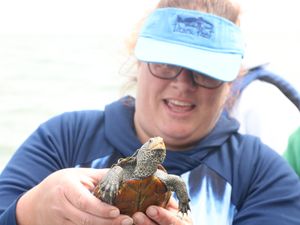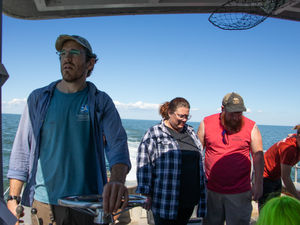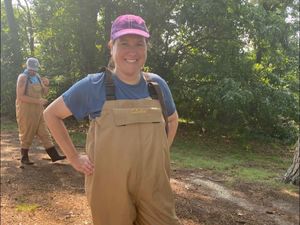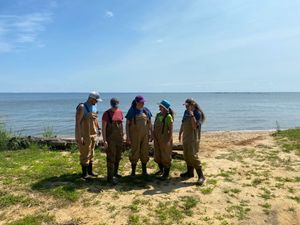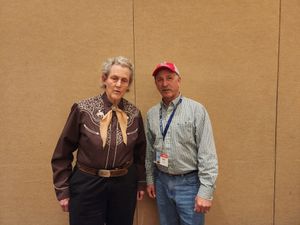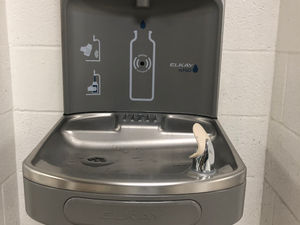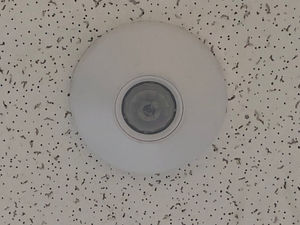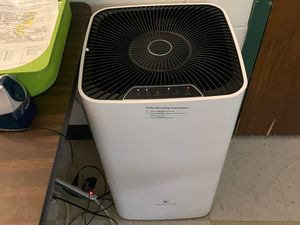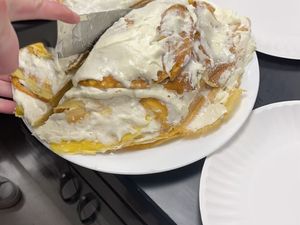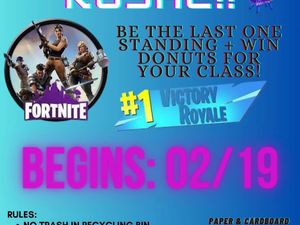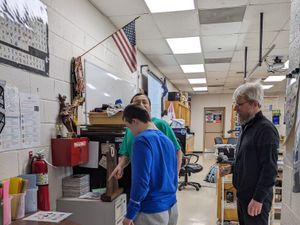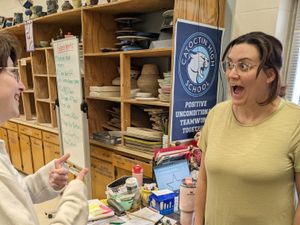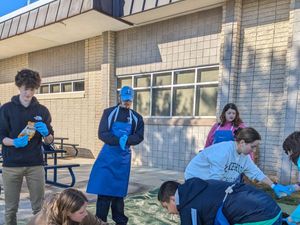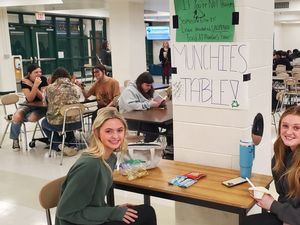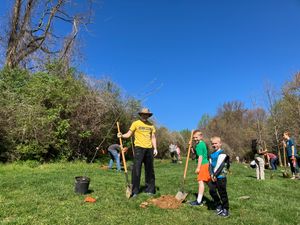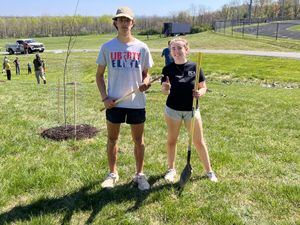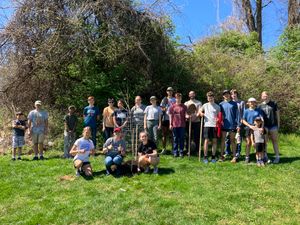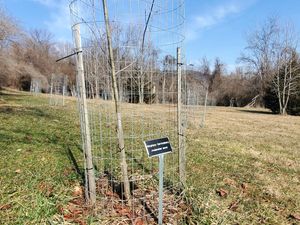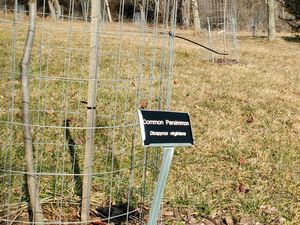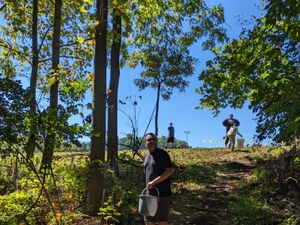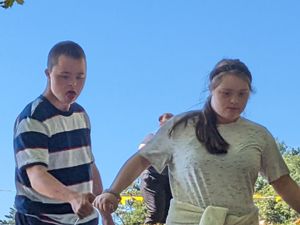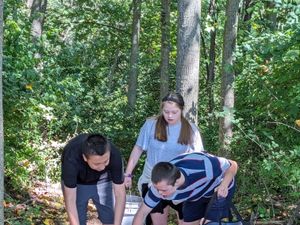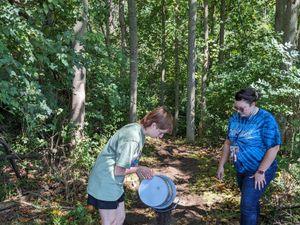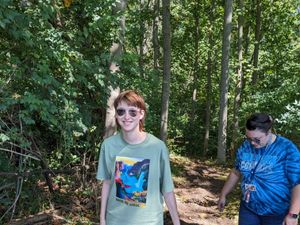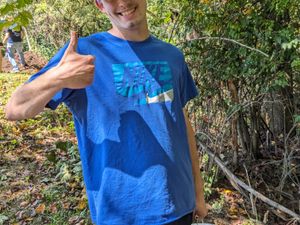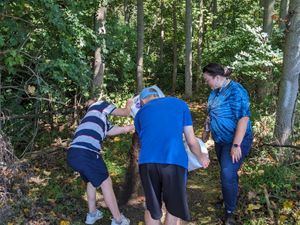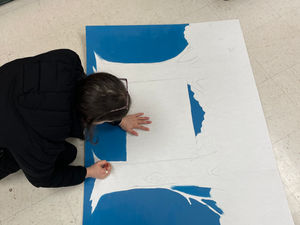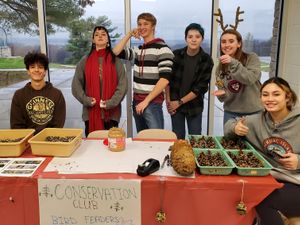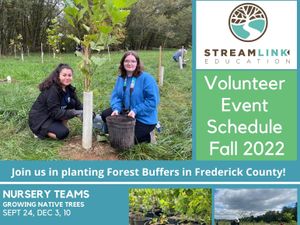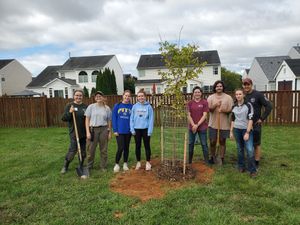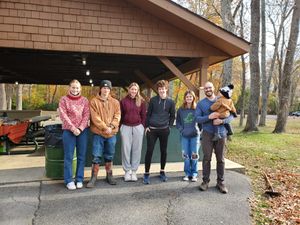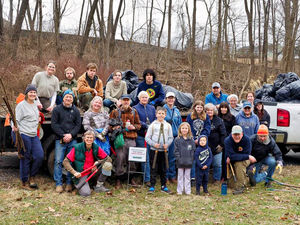Systemic Sustainability
Environmental Curriculum and Instruction
1.1 Curriculum and Instruction
Elementary & middle schools must provide one example of outdoor/environmental instruction per grade level.
High schools must provide one example of outdoor/environmental instruction in four subjects (which may include multiple different differents sciences).
Comprehensive, semester-long earth sciences research class in which students received environmental education about anthropogenic impacts. Students read "The Sixth Extinction" by Elizabeth Colbert and had intensive discussions about the impacts of human activity such as mass extinction, alteration of ecosystems, rise of new diseases etc. Subsequently, students complete an original research project and create a scientific poster. The course culminates in a scientific poster presentation where students share and defend their research at the county Earth and Space Science Lab. The course supports all 5 MD Environmental Literacy Standards.
Students utilize textual evidence from "Lord of the Flies" to make images that show how humans have impacted the environment of the island. Common impacts shown are deforestation, forest fires, and refuse. This supports MD Environmental Literacy Standard 2 Human Dependence on Earth Systems and Natural Resources and Standard 3 Environmental Impact of Human Activity.
Before image with text evidence
After image with text evidence
Before and After image showing forest fires and refuse
Before and after image with text evidence that illustrate impacts like deforestation, lack of waste management, and forest fires
Before and After with text evidence
lord of the flies assignment description (36.3 KB)
Assignment Description
Students in AP Biology and AP Environmental complete a stream study of Owens Creek which runs along the Northern border of our campus. They investigate different aspects of stream health and then use their collected data to make arguments as to how healthy the stream is. The background information and write-up is based on resources from the Alice Ferguson Foundation and supports MD Environmental Literacy Standard 2 Human Dependence on Earth Systems and Natural Resources and Standard 3 Environmental Impacts of Human Activity. Additionally, discussions around how public policy affects stream health supports Standard 5 Individual and Collective Responses to Environmental Change.
Ali and Kacey working on their stream study
Molly taking a break after collecting macroinvertebrates
Ali getting in position to catch the orange we used to measure stream speed
Stream Study_ Back Ground Information (956.98 KB)
Background reading that students had to do to prepare for the stream study based on resources from the Alice Ferguson Foundation
Students observe the life cycle of the painted lady butterfly, construct trophic level diagrams, and measure the efficiency of energy transfer between trophic levels. Students take measurements of all food the caterpillars consume, all the frass they produce, and their final masses to show that energy transfer is highly inefficient. This supports MD Environmental Literacy Standard 2 Human Dependence on Earth Systems and Natural Resources because the lab prompts conversations about why vegetarian diets are more sustainable.
Energy Dynamics_ Butterfly Lab Data (46.63 KB)
Group data
Energy Dynamics Butterfly Lab (615.94 KB)
Lab write-up with calculations
The Human Impact Film Festival is a project completed in Honors Biology and is a collaborative effort between science and the media specialist. Students research human impacts on the environment related to habitat loss, invasive species, pollution, climate change, overpopulation, and overuse of resources. They then design and evaluate solutions to their chosen issue. All of this information is used to create a 5 minute documentary to educate the public on the issue and inform them of the best way to help. Student films are then shown at the Thurmont Regional Library and a winner is selected by judges from local organizations. This project supports all 5 Environmental Literacy standards.
Student Winners and Community Partners at Thurmont Regional Library during 2023 Human Impact Film Festival. Community judges included Davin Faris from Sunrise Frederick, Austin Stiegemeier an environmental artist and art professor at Gettysburg College, Janet Ady and Carey Murphy from Mobilize Frederick, Michele Maze from the Thurmont Green Team, and Shelley Miller from Catoctin Forest Alliance
Video playlist from the 2023 Human Impact Film Festival. Thumbnails are of the student made films and include titles and the students that made the project.
Playlist - Environmental Literacy Project_EngelstatterCHS (237.01 KB)
Student facing playlist that outlines what students experience and complete during the course of the project
Environmental Literacy Project Final Submission (Responses) - Form Responses 1 (45.01 KB)
This document includes links to the students' videos as well as their research note-taking sheets
Green Schools_Mindy Film Festival (403.5 KB)
Correspondence regarding film festival set-up and promotion
Teachers in the English, science, and social studies departments discussed ways students could be empowered by thinking about the future instead of feeling hopeless in the face of daunting challenges. Many issues of the present are legacies of colonial economic and political systems, but they continue to impact the future. What might the future look like if we just eradicated that past?
The idea this activity explores is that to create better futures, we need to first imagine them. Students were asked to write utopian speculative fiction that is set in a future where their chosen social or environmental issue has been solved. This supports Environmental Literacy Standards 4 and 5.
Delaney Hench - 38 Decolonizing the Future Creative Writing - 4916166 (53.83 KB)
Speculative fiction/poem about better waste management
Benjamin Harbaugh - 38 Decolonizing the Future Creative Writing - 4952474 (49.89 KB)
Speculative fiction about banning fossil fuel engines and moving the earth away from the sun
Lillian Grable - 38 Decolonizing the Future Creative Writing - 4993762 (53 KB)
Poem that imagines how women would have built society and how they can remake society still
Jack Fordham - 38 Decolonizing the Future Creative Writing - 8985988 (81.03 KB)
Short story about the rebirth of a better civilization using technology to undo humanity's wrongs
Students investigate the links between biodiversity and ecosystem stability by playing a role-playing game where they try to survive as the first settlers in early Peru 5,000 years ago. Students are given a few different sources of food and have to set up their society to maximize food production. They do the simulation over 20 rounds and face different disturbances at the end of each round. For example, some years an El Nino may impact their fishing, or an earthquake may destroy their potato crops. Throughout the simulation, the population grows and students struggle to survive and feed their people unless they diversify their resources. Standards 2 and 4 are supported by this activity.
Students determining where to put their workers on their gameboard and recording food production totals.
Student-made graph showing societal functioning over 20 rounds. Arrows indicate disturbances and instances where food totals drop below population show resilience.
Norte Chico_ Modeling Resistance and Resilience (341.64 KB)
Slides to introduce the assignment. It starts with a discussion of an E.O. Wilson quote, leads to an exploration of where the first civilizations sprung up, and prompts discussion on the unique features of Peru and their reliance on fishing to sustain their civilization.
Evan Stream - 12 Norte Chi - 3314592. Norte Chico_ Modeling Resistance and Resilience (1.83 MB)
Student Lab write-up. The last question in the lab discusses the links between biodiversity and ecosystem resilience, and also how different agricultural practices influence how susceptible crops are to pests.
Copy of Norte Chico Data Table (53.68 KB)
Student data table recording food totals, worker placements, and disturbances over 20 rounds.
Students design a fully sealed ecosystem in a bottle to explore the cycling of essential elements carbon, hydrogen, oxygen, nitrogen, and phosphorous through biotic and abiotic components of an ecosystem. Students use a minimum of 2 containers, one is for an aquatic ecosystem and the other is for a terrestrial ecosystem. Both ecosystems must be able to interact in some way to insure the proper cycling of elements. Students observe the ecosystem over the course of a month and write a lab report that reflects on nutrient cycles, the interrelationships of organisms, and the relevance of scientific modeling to understand real ecosystems. This project supports Standard 2.
Students checking their bottle biomes
Students entering data for their daily observations
Bottle biomes in the science greenhouse
Bottle biomes placed in window. This one has a healthy aquatic ecosystem with duckweed, elodea, and a guppy
Oxygen bubbles rising from the Elodea showing that photosynthesis is taking place
Ecosystem+in+a+Bottle+Lab+Report.docx (6.77 MB)
Student written lab report from honors biology
Project_ Ecosystem In a Bottle (166.86 KB)
Overview of project and rough draft document for lab reports
Through yearly field trips with the Chesapeake Bay Foundation, our science students have learned how people living in the bay are affected by the behavior of all residents in the bay watershed. Students learn about population dynamics, human impacts on aquatic organisms, and they get firsthand experience with field research work. Photography students document the trips using photojournalism techniques and wildlife photography. These trips support all 5 MD Environmental Literacy Standards and they also create lifelong memories for our students.
Students find soils from different areas of our campus and make a hypothesis about which soils will be best for the growth of plants. They then use a Nitty Gritty soil kit to test the physical and chemical properties of their soil. After all of the soils are tested students, rank which soil would be the most conducive for growing plants and have to justify their ranking.
Testing soil and recording data
Shaking the test tube of soil
Doing the chemical tests
Digging up some soil for the lab
Getting the goods!
Hurley Soil Lab (181.74 KB)
Lab write-up
Students from Catoctin High School traveled to New Brunswick Canada to represent Maryland and compete in the 2023 NCF-Envirothon Competition. Students in Envirothon compete in events that target forestry, aquatics, soils, and wildlife skills.
1.2 Green School Awareness
1.2.1 School Wide Awareness - Staff
Demonstrate that all school personnel are aware of your school's Green School status and application process.
Student Green team leaders from the Conservation Club presented to staff during the usual twice monthly professional learning. Students informed staff on the green school's process and held a brainstorming session to capture staff ideas on projects we could accomplish. Staff support MD state environmental literacy requirements because they are embedded in Frederick County curricula. Biology, Government, Modern World History, and American Studies 2 cover the 5 environmental literacy standards and all are graduation requirements.
Students informed staff of our intent to apply during professional learning sessions. They covered the 3 objectives and discussed our plans to meet each one. After discussing the green schools process, students listened to staff to see what was important to them and they captured staff thoughts on a collaborative Jamboard.
CCC PL Presentation (813.75 KB)
Conservation Club presentation given to staff at professional learning sessions.
1.2.2 School-Wide Celebration
Demonstrate how your school celebrates beig a Green School by hosting a school-wide environmentally-focused event open to all students.
Every year on the last day of school we have an event called the Annual Day of Service. We celebrate all of the accomplishments of our service-oriented clubs and give students an opportunity to complete an act of service before they take off for the summer. Service is one of the most important aspects of feeling connected to the wider community, and this event also meets our student's social-emotional needs.
For 2023 the Conservation Club was celebrating the 43 Native trees we planted with the MD DNR. Students who weren't involved in the initial planting were given an opportunity to see our hard work and help water, weed, and re-mulch. Additional campus clean-ups of the Cougar Trail and athletic fields we also completed. We were also able to do work in the wider feeder pattern, so students were able to volunteer at the middle school and 2 different elementary schools. Activities carried out at the elementary schools included campus litter removal.
Students picking up litter at Emmitsburg Elementary School
This is a photograph of what the 43 trees looked like after the event. They are newly mulched, weeded, and watered, and all litter had been removed from the area.
Day of Service 2023 (42.17 KB)
SGA brainstorming document to organize the event
Chad Zimnmerman last announcement...Hour of Service (59.95 KB)
Morning announcement to remind students to sign up for an act of service
CHS Hour of Service 2023 - Google Forms (384.54 KB)
Google form that outlines the choices students can make to get involved and help their school and community
Environmental Professional Development for Teachers
1.3.1 Environmental Professional Development for Teachers
Demonstrate that 10% of staff have completed an environmental PD. Instructional staff is defined as any staff that manages a gradebook.
- New Schools must have all PD completed within the past 2 academic years.
- Renewing schools must have all PD completed within the past 4 academic years.
A teacher who has participated in multiple workshops may only be counted once..
All 5 members of Catoctin High School's Science department have either led or have been part of environmental PD in the past 2 years. Teachers have undergone training with the Chesapeake Bay Foundation at both Smith Island and Port Isobel, they have received environmental PD, including green schools training, during curriculum and in-service days, and they have taken classes for MSDE credit with MAEOE. Our Agriculture teachers have also attended the Maryland Agricultural Education Conference and the National FFA Leadership Development Workshop.
Completed a multi-month workshop course hosted by MAEOE titled "Addressing Environmental Justice." Sessions were held once a month with activities to be completed in class or with the Catoctin Conservation Club. Students will be completing an environmental justice action project later in the spring based on resources provided by this course.
Brian Brotherton's reflection after completing activities from the Environmental Justice in the Classroom with his Biology classes.
Environmental Justice In the Classroom- Session 1 (611.2 KB)
Resources from the first session that were used to help students observe their environment and define what a healthy environment is.
Community Needs slideshow (320.45 KB)
Community Needs slideshow created based on class discussions about issues Frederick County faces.
Catoctin's science department attended a presentation about using student made environmental films in science class during our January inservice. Brian Brotherton from Catoctin collaborated with Sharon Steger from Middletown and Janet Ady from Mobilize Frederick on the presentation. The goal was to promote the Human Impact Film Festival and to increase the adoption of video as a powerful and engaging medium for students to work in.
Film Festival PD Slideshow (4.74 MB)
Film Slides from January in-service
Beth McCook from Urbana High School presented on how we could start a Youth Climate Institute Chapter at our school. Students become climate ambassadors and complete action projects and service leading to a capstone project and presentation.
Youth Climate Institute Chapters w Green Schools_ FCPS Inservice_1.17.24 (3.7 MB)
Youth Climate Slideshow from January in-service
On a trip to Smith Island with the CBF, teachers learned inquiry based learning techniques and S.T.E.M. practices to empower students to explore wetlands, grass beds, oyster reefs, and the health of bay ecosystems.
On a trip to Port Isobel with the CBF, teachers learned inquiry based learning techniques and S.T.E.M. practices to empower students to explore wetlands, grass beds, oyster reefs, and the health of bay ecosystems. Science teachers were accompanied by the visual and performing arts department chair who is planning to incorporate photojournalism and environmental photography into our photography program.
Sarah attended the Maryland Agricultural Education Conference in St. Mary's county Maryland. She learned how to identify invasive species and used marine life to determine the health of aquatic ecosystems.
Barry attended the National FFA Convention in Indianapolis. While there he attended the leadership development conference and met Temple Grandin. Barry supports environmental literacy as an advisor for both FFA and Envirothon.
1.4 Achieving Sustainable Schools
1.4.1 School-Wide Staff Sustainability
Demonstrate the sustainability practices your teachers, staff, and other personnel have implemented school-wide to make your school green. Any actions involving students belong under Objective 2.
-Light sensors are located in each bathroom within Catoctin High School. These sensors turn off the lights after no movement is detected for a period of time. These sensors conserve energy from being used to power lights in empty rooms. -Air Filters filters were purchased by Frederick County Public Schools from a federal grant during the pandemic. Each classroom has been equipped with an air purifier. -Multiple water bottle refill stations were installed throughout the school. All of the water refill stations filter water that make it appropriate for consumption. Additionally, signs near sinks indicate water unfit for consumption.
Bottle refill station installed in October of 2022 Water bottle refills stations were installed over the coronavirus pandemic. There is a plaque in the upper left hand corner indicating Catoctin High School. Use of reusable water bottles has increased as a result and less single use plastic water bottles are consumed. These stations were subsidized by external grants.
Motion Sensors for lights installed in October of 2022
An air purifier by the company Medify Air in a classroom. The air purifier filters allergens, VOC's, contaminant, odors, and particles down to 0.1 microns in size.
1.4.2 Systemic Partnership
Demonstrate one partnership with a central office or board within the school system that supports part of the Maryland Green Schools Program. Any partnerships outside of your school system belong under Objective 3.
During the course of the Green Schools application and our application process for the MSDE School Waste and Composting Program, food and nutrition services within FCPS updated our serving lines in the cafeteria. Their intention was to increase the speed of service to sell more lunches. However, this led to increases in both food waste and the use of non-recyclable plastics. Teachers and the custodial staff expressed their concerns to the Catoctin Conservation Club advisor. This led to multiple meetings with food and nutrition services, and the new sustainability officer. Solutions are currently in the works, and food services is now planning to be involved in composting their waste.
Green Schools_Dawn_Matt emails (665.04 KB)
1/3 Initial e-mail chain to our sustainability officer after the first round of meetings with food and nutrition service proved not to be fruitful. The meeting that came of this included the conservation club advisor, sustainability officer, and food and nutrition services and the discussion was about how to move forward and find a solution to the plastic and food waste problem. Additionally, the conservation club advisor and sustainability officer had a separate meeting to discuss decarbonizing our pension, impact investing, sourcing of energy, and other projects we could work on to steer FCPS to better practices.
Green Schools_Rebecca e-mails (86.95 KB)
2/3 Correspondence about how the vendor of the new lines will express our concerns to the food and nutrition services director.
Green Schools_Rebecca_Erin_Matt (884.69 KB)
3/3 Most recent e-mail thread regarding the MSDE grant and how food and nutrition services can support our efforts.
Student Action
Schools must document eight total actions that address at least three of the listed sustainability practices.
These are student actions not adult actions. Adult sustainable actions can be documented in Objective 1.4.
2.1 Water Conservation/Pollution Prevention
2.1 Water Conservation/Pollution Prevention
No records were added by the school.
2.2 Energy Conservation
2.2 Energy Conservation
During AP Environmental Science, students were inspired to cook a vegetarian lunch after calculating their ecological foot print. Students learned about the environmental impact of the meat industry, and learned they could reduce their food consumption carbon footprint by eating lower on the food chain. Students designed their own recipes to encourage eating less meat and hosted a lunch for science students and the teachers in the science department.
Helen Xia - Ecological Footprints Web Exercise (Tues Jan 17) - 2979728 (464.56 KB)
AP Environmental assignment that inspired students to make the vegetarian lunch.
2.3 Solid Waste Reduction
2.3 Solid Waste Reduction
The Recycling Battle Royale is a student-led, school-wide recycling challenge that is video game themed to encourage participation. It is a collaboration between the Learning for Life Program and the Conservation Club. Additionally, student leaders presented to the students in each teacher's classroom during built-in flex periods. Currently, our recycling compliance is around 80% every day, and before the challenge it was close to zero. This has been an incredible behavior change in the school in a very short period of time.
An example of the many posters made to advertise the Recycling Battle Royale.
Students made and labeled 30+ recycling lids from used cardboard trim-folds, which were then placed on top of recycling cans in classrooms. Additionally, recycling guides were attached to each can.
Learning for Life students checking for improperly recycled items in a chemistry classroom
Learning for Life students checking for improperly recycled items in an art classroom. Looks like everything was in the right place!
Learning for Life students discussing and organizing how they are going to check the recycling daily
Catoctin High School has been doing a lot of work toward implementing a composting program including advocacy, grant writing, and working with administrators. At the time of this application's due date, we have been awarded the MSDE School Waste Reduction and Composting Grant for $2,820, but are waiting on the funds to be distributed. Advocacy has included speaking at county budget town halls, board of ed meetings, and meeting with FCPS food and nutrition services and facilities to discuss sustainable practices.
A waste sort was conducted to measure the composition of trash, recyclables, and compostable items. This was a collaboration between the Catoctin Conservation Club and Learning for Life. The data collected was used for advocacy within our local government and completing a waste reduction grant provided for by the MD General Assembly bill SB-124. We determined that 56% of all of our waste was actually compostable.
Catoctin High School SWRC School Award Letter (136.04 KB)
Letter from Zachary Carey informing us that we have been awarded the MSDE School Waste Reduction and Composting Grant
Kami Export - SchoolWasteReductionCompostingProgramApplication (1) (777.4 KB)
MSDE School Waste Reduction and Composting Grant Application. This was researched, written, and completed by 4 of our students.
Not only do Catoctin High School (CHS) students focus on sustainability, they also carry out environmental justice initiatives such as food recovery. This decreases the amount of food that enters the waste stream and also feeds disadvantaged people in our community since more than 30%-40% of CHS families qualify for free or reduced meals.
The Student Government Association (SGA) hosted a week-long clothing swap between students. Clothing swaps rely on clothing donations, which decreases unnecessary clothing entering the waste stream. Clothing swaps also disincentivize consumer participation in fast fashion, a major contributor to waste and carbon emissions.
Clothing Swap 2022 final (34.43 KB)
Flyer created by the SGA to promote the clothing swap.
2.4 Habitat Restoration
2.4 Habitat Restoration
Previously deforested areas on Catoctin's otherwise foliaged areas were reclaimed through a tree planting event that took place on April 13th. 43 native Maryland tree species were planted in partnership with the Maryland Department of Natural Resources. The $2,717 of funding for the planting was provided by a grant through the state of Maryland Department of Transportation. The cultivation of native trees provides habitat and food for native species. Fruiting trees were planted to be a future source of fresh food for students, wildlife, and to educate students about agroforestry.
Students, school staff, and community members were all involved in the tree planting. Occasionally, students perform tree maintenance. On the last day of school in 2023, SGA and the Conservation Club partnered for a watering bucket brigade and weeding of the trees.
Alex and Natalie enjoying the tree planting
Group photo showing student planting volunteers (plus Anna Twigg and Brian Brotherton)
MUCFC CHS Final Grant Application (1.83 MB)
Final MUCFC grant application written by Brian Brotherton from Catoctin High School and Anna Twigg from MD DNR
2.5 Opportunities for Nature Exploration
2.5 Opportunities for Nature Exploration
Club members installed 19 signs identifying the native trees that were planted the previous spring. The signs are used by members of Envirothon and environmental science classes to check their tree identification skills. The area is also used during cross country meets, so other students in the region get to enjoy the trees and can learn as they pass through.
Tree Planting Sign Order Tree Signs.com (368.01 KB)
Order form for the tree identification signs
Students in the Learning for Life program performed much needed maintenance on our nature trail called the Cougar Trail. They removed weeds, removed rocks that made the trail less accessible, and added mulch to many areas. In total they restored 1,700 feet of overgrown, unusable trail into what became part of our school's cross country track. This trail is now often used by science classes and agriculture classes for education, and used by sports teams for its rugged training terrain.
2.6 Responsible Transportation
2.6 Responsible Transportation
No records were added by the school.
2.7 Healthy Indoor Environments
2.7 Healthy Indoor Environments
Catoctin High School has been using compostable trays for the past few years. Recently, Frederick County Public Schools has replaced some compostable options with plastic. As a result, CHS students have aggressively voiced their disapproval by writing letters, creating petitions, attending Board meetings, speaking with leaders, and forming alliances with other FCPS schools.
fcps-needs-to-implement-sustainability-in-all-fcps-schools (118.26 KB)
A petition started by a CHS student that has garnered the support of students, staff, and parents across Frederick County Public Schools. The petition calls for elimination of plastic clamshells county-wide, and support for composting and food recovery programs.
FCPS Funding _ fredericknewspost (213.82 KB)
2 Students from Catoctin High School discussed sustainable changes that need to be made within FCPS, specifically getting rid of the plastic clamshell packaging. This is a Frederick News Post article that mentioned their advocacy.
Over 270 plants were distributed by horticulture students for the purpose of improving air quality within Catoctin High School and within student homes. Another 236 plants currently reside in the science department greenhouse to be used in environmental education. All plants were propagated in school greenhouses.
Three students from Catoctin High School discussed sustainable changes that need to be made within Frederick County. Specifically, they asked for support for composting programs, including expanding the composting pilot in Frederick City, and for ways better waste management could save, or even make money. They also discussed funding for more engaging environmental education by partnering with the county parks department.
Students talked with local government officials such as County Executive Fitzwater and Thurmont Mayor Kinnard.
District 5 residents speak on environment (524.46 KB)
Frederick News Post article that quotes the students and highlights some of the issues they discussed at the budget forum.
2.8 Citzen/Community/Participatory Science
2.8 Citizen/Community/Participatory Science
No records were added by the school.
Community Partnership
Demonstrate that your school is forming long-term partnerships to foster environmental stewardship and cultivate community wellness through real-world connections.
3.1 Community Partnerships
3.1.1 School Active in Community
Describe at least one environmentally-focused partnership in which your school is working to benefit your community.
Continued volunteer efforts with Chesapeake Bay Foundation's environmental conservation events. These include tree plantings in the Chesapeake Bay Watershed.
Catoctin students presented at the Thurmont Green Fest on April 15th, 2023, and will be presenting at Thurmont Green Fest 2024. Thurmont Green Fest is hosted by the Thurmont Regional Library and is an excellent networking opportunity for students to connect with local organizations. We have also partnered with the Thurmont Regional Library and Cunningham Falls State Park to pull invasive Japanese barberry from the park annually. The first event was April 2, 2023 and this year it will be on March 2nd.
Green School_Mindy Thurmont Library (1.05 MB)
Planning emails to partner with the library and park on invasive species pull and green fest presentations.
Catoctin students attended the Youth Environmental Summit hosted by the Rotary Club of Southern Frederick County on November 19th, 2023. Topics discussed include food recovery and composting, funding for free tree plantings, plastics recovery, sustainable architecture, lithium-Ion recovery, and green school certification.
Gmail - Get Ready for the Environmental Youth Summit! (72.64 KB)
Correspondence between the Bar-T Youth Climate Summit organizers and attendees
Santa's Workshop is a free, student-run event at Catoctin High School for children within the community. At this event, Catoctin Conservation Club hosts a bird feeder station where children are educated on native birds. Catoctin Conservation Club also hosts a plant sale during this event.
Continued student volunteer efforts for Streamlink tree planting events in the Emmitsburg and Thurmont areas. Numerous plantings have been attended since 2021.
Sign-up StreamLink (133.5 KB)
email confirmation showing event sign-up
Catoctin students participated in a native tree planting hosted by Maryland DNR in Walkersville, MD on 9/30/2023.
Catoctin students participate in invasive species pulls hosted by the Thurmont Green Team. These pulls focus on Japanese Barberry, a highly aggressive invasive plant found all throughout our area. We have also helped the Thurmont Green Team and town of Thurmont plant trees in local parks with MD DNR.
3.1.2 Community Active in the School
Describe at least one partnership in which a community partner is benefitting the school. These actions and projects occur on or near school grounds with support from the partner.
Mobilize Frederick has been involved with Catoctin High School since the beginning of our Green Schools journey 2 years ago. They provided us with professional development at inservice days in August of 2022 and 2023. Since that initial meeting, they have supported us financially with $500 worth of water testing equipment and gardening supplies, and they paid for our Green Schools application fee. Carey Murphy and Janet Ady were both judges at the 2nd Annual Human Impact Film Festival. They have included us in their climate conference and have connected us to a wide network of like-minded groups. They have also helped the students become advocates for change in our county. We owe them!
5. MF Green Schools one pager_2022 (164.84 KB)
Initial Mobilize Frederick introduction letter that kick started our green school's journey
Mobilize_Action Kits (195.53 KB)
Email thread about the action kits they are providing for us
Mobilize_Advocacy 1 (251.67 KB)
Email thread discussing advocacy and lifting student voices up at the board of education, and who to contact for help in grant writing
Mobilize_Advocacy 2 (193.07 KB)
Email thread providing students with resources for their statements. Students used this information to then advocate for change within the county and the school system.
Mobilize_Money (71.47 KB)
Email thread about how Mobilize was paying our application fee
Mobilize_Shout Out (179.59 KB)
Email chain about Mobilize recognizing us at their climate summit at Hood College
Mobilize_Tree Planting and Film Festival (492.5 KB)
Email chain regarding help being film festival judges
3.2 Additional Achievements
3.2 Additional Achievements optional
Share any environmentally-related awards, special recognition, certifications, or other achievements that your school, staff or students have accomplished.
The PLANT Award is recognition for communities who care for their trees. Communities of all types can receive the award— schools, HOAs, parks, local governments, government facilities, scout troops and churches, just to name a few.
Awarded for Catoctin native tree planting on 4/13/23. Total of 36 volunteers, with a mix of students from all grade levels and outside volunteers.
chs volunteer list (245.95 KB)
List of volunteers at 4/12/23 tree planting
Catoctin MUCFC-Grant-FinalReport (207.6 KB)
Official MUCFC grant application
PLANT Application - PLANT_application (1.59 MB)
Official PLANT Award application

